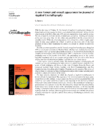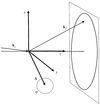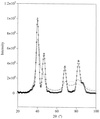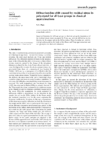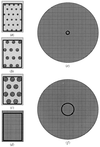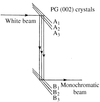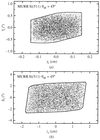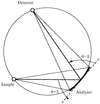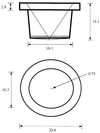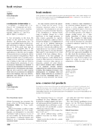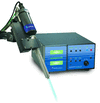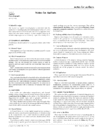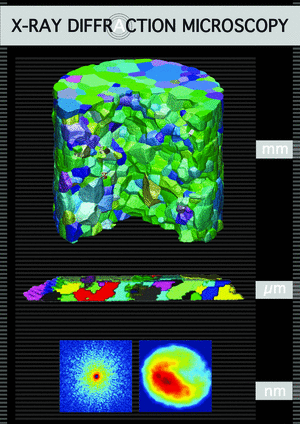issue contents
February 2000 issue

Cover illustration: Reorientation pathways of the octahedral PF6 anion in KPF6, calculated by an evolution algorithm. Courtesy of K. Knorr (University Kiel, Earth Scences - Mineralogy) and Fritz Mädler (HMI Berlin).
editorial
Free 

research papers
The crystalline perfection of silicon crystals grown by the float zone (FZ) method is generally slightly lower than that of crystals grown by the Czochralski (Cz) technique, which have higher oxygen content. High-resolution X-ray diffraction studies and infrared-absorption measurements have shown that, if the level of oxygen in FZ silicon crystals is increased by annealing, from 1.3 × 1017 to 13 × 1017 atoms cm (typical values for Cz crystals), the degree of perfection of FZ crystals increases remarkably, approaching that of the Cz crystals.
(typical values for Cz crystals), the degree of perfection of FZ crystals increases remarkably, approaching that of the Cz crystals.
A computer program for on-line crystal orientation measurements based on spot and Kikuchi electron diffraction patterns in TEM is presented. The program facilitates the complete characterization of lattice defects, such as dislocations and grain boundaries.
A new strategy to analyse both the mechanical and the metallurgical state in high-stress gradient zones is proposed. The measurement and treatment methods have been adapted and a complete modelling of the X-ray source has been developed to account for the local intensity distribution.
Correction of specimen absorption in X-ray diffuse scattering experiments with area-detector systems
Methods for the correction of specimen absorption, dedicated to two-dimensional area-detector systems and broad diffuse scattering phenomena, are implemented and tested. Synchrotron radiation diffraction experiments and numerical calculations are used to study the influence of experimental parameters on the accuracy of the absorption correction which is applied pixel-wise.
The feasibility of a specific six-circle κ diffractometer for measuring three-beam interference profiles is outlined.
Dispersive diffraction allows the simultaneous measurement of diffracted intensities over an energy range. This method has been developed and a procedure for the quantitative integration of dispersive diffraction images for continuous (DAFS-like) and discrete (MAD-like) experiments is described.
The dynamical structural changes of 30Li2O·70TeO2 glass were mainly studied by in situ high-temperature X-ray diffraction. The phase transitions of lithium tellurite at high temperature were clarified, including reversible changes between α-Li2Te2O5 and β-Li2Te2O5.
The X-ray diffraction pattern of powdered 1-Cl-4-NO2-benzene was measured at several temperatures in order to characterize the structure of two different phases.
The accuracy with which it is possible to determine atomic coordinates of light atoms at arbitrary positions using X-ray powder data alone is demonstrated. The results are compared with those of a single-crystal study on the same compound.
Tools for nanopowder diffraction analysis, based on simulation, are proposed.
The crystal structure of α-silicon nitride (Si3N4) was refined by the Rietveld method using synchrotron radiation powder diffraction data. A refinement procedure using a new weight function for least-squares fitting was studied, and guidelines for an unbiased refinement procedure were derived.
Expressions are derived within the Voigt and Reuss approximations, describing the anisotropic diffraction-line shift caused by the elastic strain in isotropic polycrystals. These expressions, appropriate for the Rietveld programs, are different for different Laue groups.
A method is proposed that removes from a diffraction pattern, in which overlapping peaks of a thin layer and a substrate are present, the substrate peaks, using a separate measurement of an uncovered substrate. The method is shown to yield good results for a TiN layer deposited on a tool-steel substrate.
It is shown that the scattering intensities of light water collected with different ratios of sample-to-beam dimension present large differences as a function of sample thickness. In particular, ratios smaller and larger than unity are considered and the results are discussed and compared with Monte Carlo simulations.
Double monochromator with three pairs of crystals for a SANS machine: Monte Carlo simulation studies
Monte Carlo calculations for the resolution and intensity of a double-crystal monochromator system for a small-angle neutron scattering machine are presented. The relative merits of this monochromator as compared to our available monochromators are discussed.
The birefringence and optical activity of AgGaS2 have been determined using a high-accuracy universal polarimeter. The data are compared with those of previous works and the connection between the optical properties and crystal structure is discussed.
A general form of the instrumental resolution function is given for X-ray reflectivity experiments.
The assumption of Gaussian line shapes and Caglioti profile functions leads to a good quality of fit in whole-pattern refinements, not only with conventional instruments, but also with focusing instruments. The quality of the fit improved on approximating instrumental line shapes with double cumulative functions.
The use of bent perfect crystals in three-axis neutron spectroscopy with position-sensitive detection is analysed. High intensities at high resolutions are achievable through focusing in scattering combined with `thickness focusing' from multilamella analysers.
Structure factors were measured for cuprite, Cu2O, using 100 keV synchrotron radiation, with an accuracy that allowed full multipole refinements.
cryocrystallography papers
This paper describes a cryocooling method, based on the use of dialysis adaptors for 24-well crystallization plates, that permits the transfer of crystals with greater ease and lower risk of mechanical damage.
short communications
Specimens of silver behenate that exhibit a high degree of preferred orientation have been prepared. Multiple (0 0 l) diffraction peaks, (0 0 1) to (0 0 48), are easily observed using a conventional laboratory X-ray diffraction instrument.
computer programs
A phase refinement program for high-resolution macromolecular structures is described that may allow the mean phase error of an initial structure solution to be reduced before inspecting a map to see how well it may fit a structural model.
In order to facilitate the three-dimensional structure comparison of proteins, software for making comparisons and searching for similarities to protein structures in databases has been developed.
MarqX can be used for an unconstrained profile fitting (pattern decomposition) or constrained modelling of the whole powder pattern (Pawley method), for single- as well as multiple-phase samples.
book reviews
Free 

new commercial products
international union of crystallography
Free 



 journal menu
journal menu









